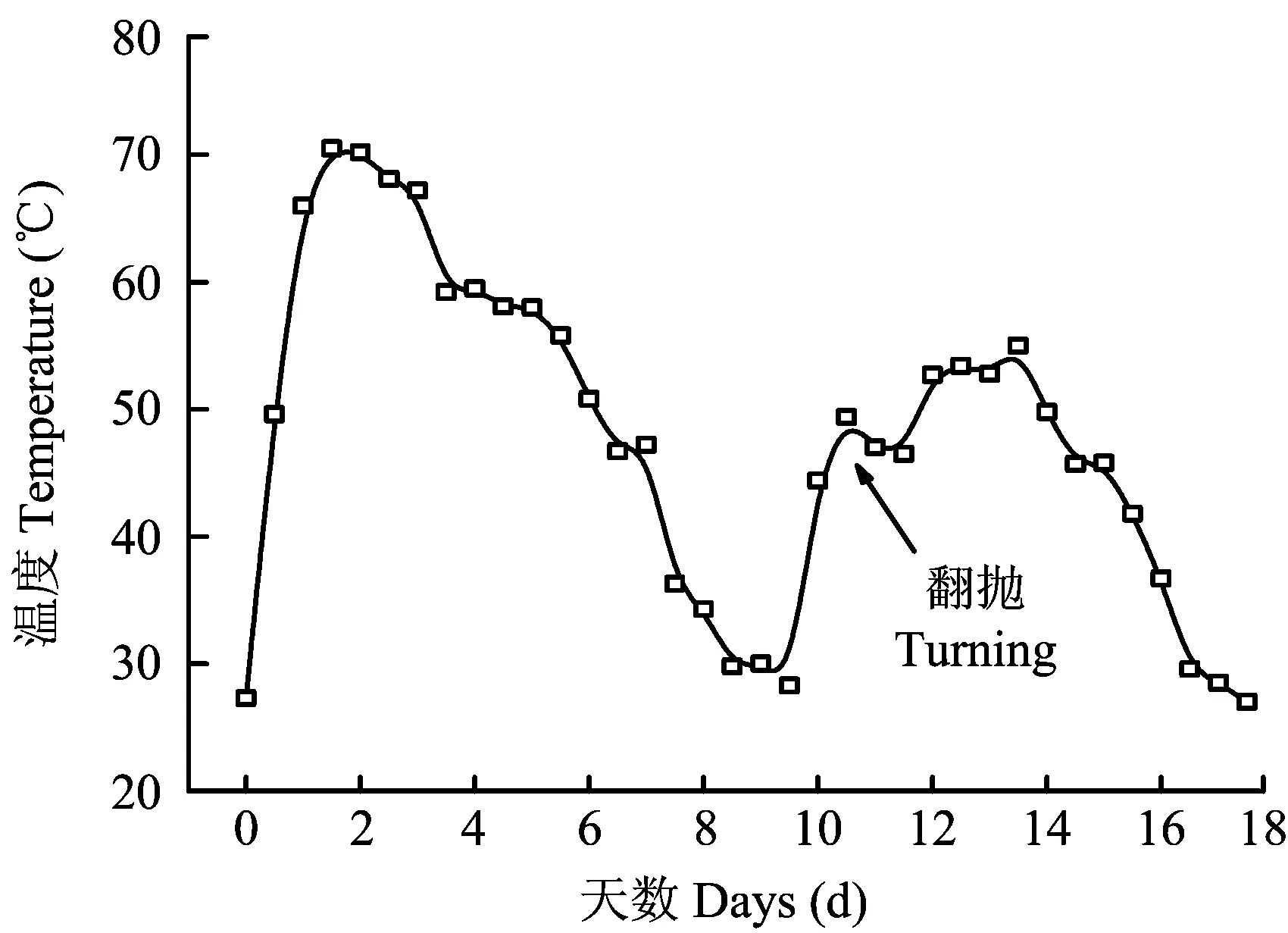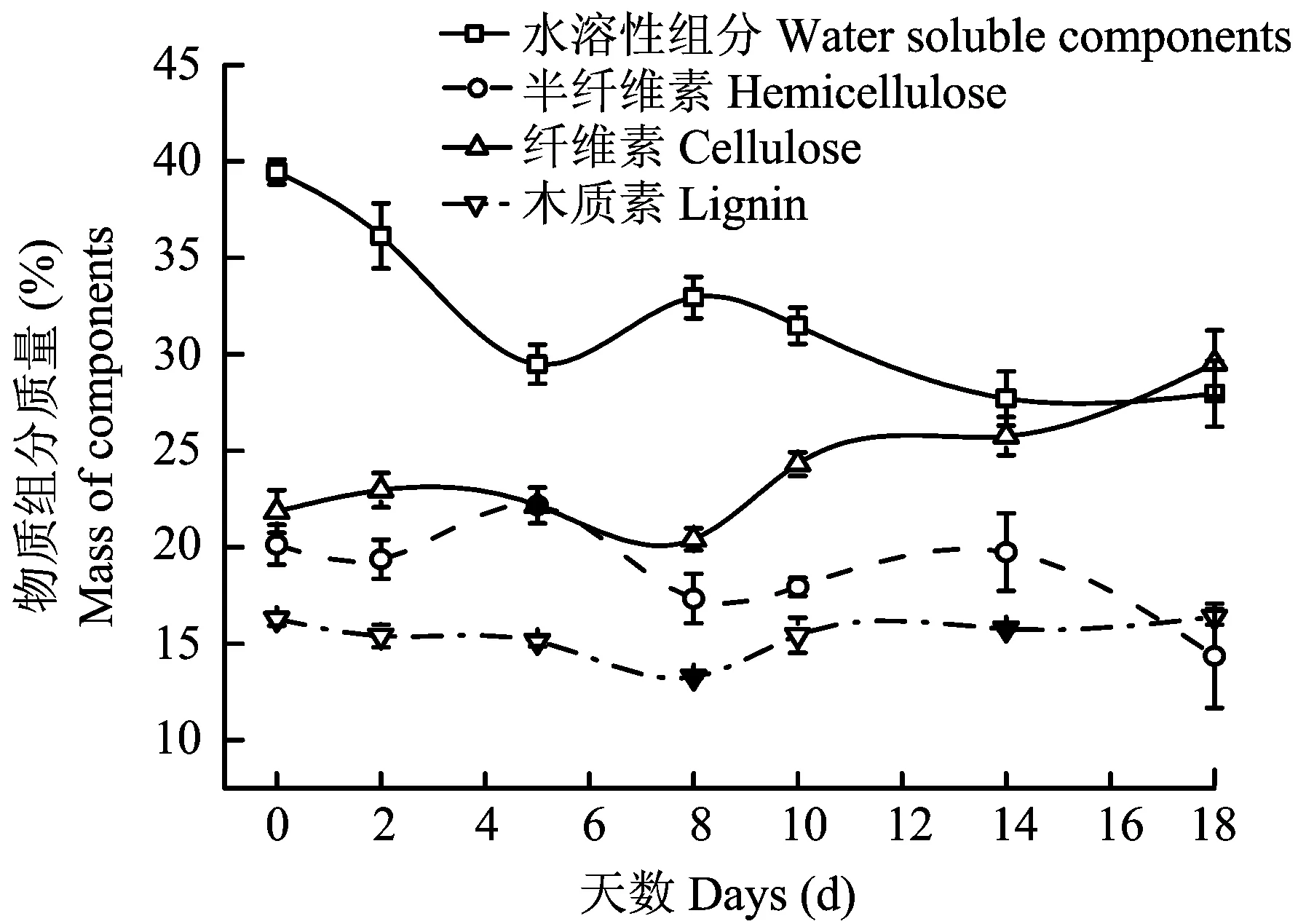城市污泥与调理剂混合堆肥过程中有机质组分的变化
牛明杰, 郑国砥, 朱彦莉, 赵馨玥, 高 定, 陈同斌
(1 中国科学院地理科学与资源研究所环境修复中心, 北京 100101; 2 中国科学院大学, 北京 100049)
城市污泥与调理剂混合堆肥过程中有机质组分的变化
牛明杰1, 2, 郑国砥1*, 朱彦莉1, 2, 赵馨玥1, 高 定1, 陈同斌1
(1 中国科学院地理科学与资源研究所环境修复中心, 北京 100101; 2 中国科学院大学, 北京 100049)

城市污泥; 堆肥; 有机质组分; 土地利用
城市污泥是城市污水处理的末端产品,含有大量的有机物质和氮、 磷等营养元素,土地利用后可以提高土壤肥力。但是污泥中有机质未腐熟,未经稳定化处理施入土壤可能引起烧苗。污泥堆肥是一种行之有效的稳定化处理技术,而且堆肥过程中微生物代谢活动能够降解有机污染物,产热形成的高温可以有效杀死病原微生物,同时堆肥化处理形成的腐殖质能够钝化重金属,降低城市污泥的危害性[1-2]。但城市脱水污泥由于含水量高(80%),粘性大,C/N值不适合,直接堆肥很难升温。污泥加入锯末、 秸秆等有机废物混合堆肥可以克服上述困难,但由于秸秆受季节限制,现在城市污泥堆肥更多的采用锯末等木材加工废料进行混合堆肥。
有机废弃物堆肥过程中,微生物的代谢作用使堆肥物料中部分有机质被转化为更加复杂稳定的大分子物质[3-6],C/N值逐渐降低[7],富里酸、 胡敏酸和腐殖质等物质含量增加。堆肥结束后,物料性质稳定,可作为有机肥料应用于土壤[8-10]。施用腐熟稳定的堆肥可以增加土壤有机质含量,改善土壤的理化性质及生物学特性,进而促进植株的生长,提高产量[11-13]。
目前,多数研究集中于城市污泥物料腐熟过程中腐殖质的形成与转化作用[14-15],但是对污泥堆肥过程中有机质组分的变化鲜有报道[16]。城市污泥堆肥中的有机质组分主要包括水溶性物质、 半纤维素、 纤维素和木质素四种成分,对物料的腐熟过程具有十分重要的影响。其中,水溶性组分主要包括淀粉、 蔗糖、 低聚糖、 果糖和氨基酸等物质,是有机物料中的重要组成部分。大多数的微生物活动发生在固-液界面,因此水溶性组分是微生物的直接物质和能量来源,水溶性组分含量的变化可以最直观的反映出堆肥过程中有机质的转化程度和物料的稳定度[17-18]。有机物料施用于土壤后,其中的水溶性有机质转化为土壤中生物活性有机质组分,其含量和动态变化可以反映土壤有效养分库的大小及其在土壤中的周转[19]。半纤维素是构成植物细胞壁的主要成分之一,它是一种混合多糖,组成结构十分复杂,半纤维素在污泥堆肥过程中被降解为碳水化合物,并为微生物的代谢活动提供能量来源。纤维素是植物细胞壁的主要骨架结构,为植物提供了抵抗重力和生物降解的支撑性架构,半纤维素结合在纤维素微纤维的表面,并且相互连接,木质素形成交织网来硬化细胞壁,形成了极为坚固的木质纤维素结构。纤维素相比于半纤维素来说较难降解,木质素一般则不能被生物降解,只能部分被微生物转化为其他物质[20],这两种物质在污泥堆肥过程中起到调节物料的营养结构和堆体结构的作用。
研究城市污泥堆肥过程中有机质组分(水溶性组分、 半纤维素、 纤维素以及木质素)的动态变化,有助于深入认识物料堆肥腐熟过程中各组分的降解难易程度,明确污泥堆肥过程中物料有机质稳定化的特点,从而调控堆肥过程,促进污泥堆肥产品的安全利用。
1 材料与方法
1.1试验设计
试验于2015年1月在上海松江污泥处理厂7号堆仓内进行。污泥来源于上海松江污水处理厂的脱水污泥,含水率80%; 调理剂为蘑菇渣与锯末的混合物(d<2 cm),返混料为其他堆仓的腐熟堆肥。根据污泥、 调理剂以及返混料的含水率和C/N值,控制初始堆体的含水率处于60%左右,C/N值为25 ∶1左右,确定三者的质量比为6 ∶3 ∶1。
试验采取强制通风静态垛堆肥,其中第10 d进行一次翻抛。堆体下部均匀设置通风管道,由鼓风机对堆体进行间歇式曝气,调节堆体的含氧量、 温度、 湿度。鼓风机由主机自动控制,曝气参数为第一阶段(72 h)曝气6 min,暂停32 min,频率为30 Hz; 第二阶段(360 h)曝气10 min,关停30 min,频率为40 Hz。
堆肥周期18 d,周期内每日9: 00、 21: 00分别测量堆体温度,取其平均值作为当天的堆体温度。周期内分别于1、 3、 6、 8、 11、 15、 18 d采集样品,在堆体内同一高度选取6个采样点,总计采样2 kg,鲜样测定堆体含水率和pH,剩余样品经过冷冻干燥并充分研磨后测定总有机碳(TOC)、 总氮(TN)、 灰分、 水溶性组分、 半纤维素、 纤维素和木质素。
1.2测定项目与方法
1.2.1 含水率以及灰分的测定取少量样品置于净质量为W1的坩埚中,准确称取样品与坩埚的总质量为W2,将坩埚放入烘箱内,105℃条件下干燥6 h,再次测定坩埚质量为W3,由此计算物料含水率。

取少量烘干后的样品置于净质量为W4的坩埚中,准确称取样品与坩埚的总质量为W5,将坩埚放入马弗炉内,550℃条件下灼烧6 h,再次测定坩埚质量为W6,由此计算物料灰分含量。

1.2.2 有机质组分的测定有机质组分的测定采用系统分析法[21],在传统Van Soest方法的基础上进行一定的优化,酸性洗涤剂修改为2 mol/L HCl溶液,木质素测定过程中增加了过夜消解的步骤。具体步骤为:


3)酸性洗涤木质素和酸不溶灰分测定将酸性洗涤纤维加入5 mL 72% H2SO4中,在20℃消化3 h, 然后加入45 mL去离子水,过夜消解。之后将残渣用重量为W5的漏斗过滤并冲洗至中性,将漏斗置于105℃烘箱中烘2 h 后,在干燥器中冷却30 min称重,至恒重为W6。消化过程中溶解部分为纤维素,不溶解的残渣为酸性洗涤木质素和酸不溶灰分,将残渣转置于重量为W7的坩埚中,然后将坩埚置于马弗炉中,于550℃条件下灼烧6 h后称重为W8,即可得出酸性洗涤木质素和酸不溶灰分的含量。
各组分物质表观含量的计算:




各物质组分降解率的计算:

式中,A0表示初始物料的灰分含量;Ai表示第i天物料灰分含量;C0表示初始物料的物质组分含量;Ci表示第i天物料的物质组分含量。
1.2.3 总有机碳和总氮的测定采用Flash2000元素分析仪测定样品中的总有机碳和总氮。仪器条件设置: 载气140 mL/min,参比100 mL/min,工作温度950℃,柱温50℃,分析时间720 s。标准试剂采用双叔丁基苯甲噻吩(C26H26N2O2S),设置四个标准点,在标准曲线系数R2≥0.999的条件下,对样品进行测定。每个样品重复测定3次。
2 结果与分析
2.1生污泥、 调理剂与返混料的基本性质
生污泥、 调理剂与返混料三者按照6∶3∶1的质量比混合形成堆肥的初始物料,通过测定其基本理化性质(表1)可知,初始物料中的可溶性物质主要来源于生污泥,半纤维素、 纤维素以及木质素主要来源于调理剂。

表1 堆肥物料的基本理化性质
2.2污泥堆肥过程中温度的动态变化
温度是污泥堆肥过程中十分重要的影响因素,直接关系到堆体内微生物活性的变化。堆体内温度升高主要源于微生物代谢活动产热,反过来又决定了微生物的代谢活性。依据污泥堆肥过程中温度的变化可以将其划分为升温期、 高温期、 降温期和稳定期4个阶段。堆体温度在55℃条件下保持3 d 以上,可以杀灭堆料中所含病原菌, 满足堆肥卫生学指标和腐熟的要求。


图1 污泥堆肥过程中堆体温度变化Fig.1 Temperature of pile during sewage sludge composting
2.3污泥堆肥过程中含水率以及pH的动态变化


图2 污泥堆肥过程中含水率以及pH的变化Fig.2 Dynamics of moisture and pH of pile during sewage sludge composting
2.4污泥堆肥过程中总有机碳(TOC)、 总氮(TN)含量的动态变化


图3 污泥堆肥过程中总有机碳和总氮含量的变化Fig.3 Dynamics of total organic carbon (TOC) and total N(TN) of pile during sewage sludge composting
2.5污泥堆肥过程中有机质组分的动态变化

图4 污泥堆肥过程中物料有机质组分成分变化Fig.4 Dynamics of organic components during sewage sludge composting
采用系统分析法,探究物料在堆肥的各个阶段的有机质组分组成情况(图4)。图4表明,堆肥初始阶段,堆肥物料中4种成分含量表现为水溶性组分>纤维素、 半纤维素、 木质素,至堆肥结束变化为纤维素>水溶性组分>木质素>半纤维素,水溶性组分以及半纤维素含量经过堆肥处理后有下降的趋势,分别由39.5%和20.1%下降为27.9%和14.4%,纤维素含量由初始的21.8%上升至29.5%,木质素含量相对稳定不变,物料成分在堆肥前后发生了显著的变化。微生物代谢活动主要利用水溶性组分进行,因此水溶性组分出现显著下降。半纤维素堆肥后有一定的降解,说明微生物代谢活动能够降解半纤维素,但是不能完全降解。随着水溶性组分和半纤维素含量的下降,纤维素和木质素含量相对呈现上升趋势,主要源于两个方面: 首先,纤维素和木质素两种组分较难降解; 其次,物料总量在堆肥后实现了减量化,共同导致了纤维素和木质素含量的上升。
根据温度指标的变化将堆肥周期划分为4个阶段: 升温期、 高温期、 降温期以及稳定期。表2为堆肥周期4个阶段内物料的各项指标以及有机质组分含量的变化趋势。堆肥过程中,物料中水溶性组分的变化趋势与总有机碳以及含水率的变化趋势保持基本一致(相关性分别为:r=0.86,P=0.014;r=0.82,P=0.023),微生物活动直接消耗水溶性物质能量,造成总有机碳含量的降低,产生的大量高温有助于水分的散失,造成了物料含水率的快速下降。半纤维素含量的变化则与总氮含量的变化相悖,主要原因是半纤维素的降解发生在降温期与稳定期,而总氮含量在该阶段因为硝态氮的积累呈现上升趋势。纤维素和木质素的降解主要发生在高温期,因为高温期部分微生物失去活性,耐高温的放线菌此时作为优势菌,纤维素和木质素作为其作用对象被降解[25]。

表2 各项指标在堆肥周期内不同阶段的变化趋势
注(Note): “↑”表示值上升Represent value ascends; “↓”表示值下降Represent value descends; “-”表示值稳定不变Represent value keeps stable.
表3表明,水溶性组分和半纤维素的总降解率分别为38.6%和38.8%,其中高温期是水溶性组分的主要降解阶段,占总降解量的65.5%; 稳定期为半纤维素的主要降解阶段,占总降解量的69.1%。纤维素和木质素仅在高温期分别有11.7%和18.5%的降解,而降温期和稳定期有一定的累积效应,这与康军等[26]的研究结果一致,可能的原因是细胞壁中纤维素受木质素的保护, 而木质素有完整而坚硬的外壳, 不易被微生物降解,因此纤维素的降解受到限制。

表3 有机质组分在堆肥周期内不同阶段的降解率(%)
注(Note): “—”表示无降解Represent no degradation.
总体上,物料组分前后的变化体现了堆肥是一个肥效增强的过程。水溶性组分主要供应微生物代谢活动所需的物质和能量,其含量直接反映了微生物代谢活动的强弱。水溶性组分经过发酵后含量逐渐稳定,避免了未腐熟物料土地利用时烧苗的潜在威胁。半纤维素、 纤维素以及木质素进入土壤后,很难被土壤中的微生物利用,经过堆肥处理后,三者均有一定程度的降解,形成生物有效性养分。因此,腐熟物料施用于土壤后,可以提高土壤中有机质含量,降低土壤的容重,改善土壤结构,提高土壤持水能力[27]。
3 结论
城市污泥与锯末蘑菇渣混合堆肥处理后,堆肥物料中有机质组分含量发生了显著变化。纤维素和木质素在堆肥过程中降解较少,仅在高温期有少量降解; 堆肥过程中水溶性组分和半纤维素降解较快,水溶性组分的主要降解阶段为高温期,高温期降解部分占总降解量的65.5%; 半纤维素的主要降解阶段为稳定期,稳定期降解部分占总降解量的69.1%,且有继续降解的趋势。通过堆肥处理,城市污泥中不稳定的有机质组分被降解,堆肥物料达到稳定化要求,以避免土地利用过程中烧苗等风险。
[1]Villasenor J, Rodriguez L, Fernandez F J. Composting domestic sewage sludge with natural zeolites in a rotary drum reactor[J]. Bioresource Technology, 2011, 102(2): 1447-1454.
[2]Gabhane J, William S P M P, Bidyadhar R,etal. Additives aided composting of green waste: Effects on organic matter degradation, compost maturity, and quality of the finished compost[J]. Bioresource Technology, 2012, 114: 382-388.
[3]高伟, 郑国砥, 高定, 等. 堆肥处理过程中猪粪有机物的动态变化特征[J]. 环境科学, 2006, 27(5): 164-168.
Gao W, Zheng G D, Gao D,etal. Transformation of organic matter during thermophilic composting of pig manure[J]. Environmental Science, 2006, 27(5):164-168.
[4]Ingelmo F, Molina M J, Soriano M D,etal. Influence of organic matter transformations on the bioavailability of heavy metals in a sludge based compost[J]. Journal of Environmental Management, 2012, 95(Suppl.): S104-S109.
[5]Hernández T, Masciandaro G, Moreno J I,etal. Changes in organic matter composition during composting of two digested sewage sludges[J]. Waste Management, 2006, 26(12): 1370-1376.
[6]Provenzano M R, Malerba A D, Pezzolla D,etal. Chemical and spectroscopic characterization of organic matter during the anaerobic digestion and successive composting of pig slurry[J]. Waste Management, 2014, 34(3): 653-660.
[7]Fels L E, Zamama M, Asli A E,etal. Assessment of biotransformation of organic matter during co-composting of sewage sludge-lignocelullosic waste by chemical, FTIR analyses, and phytotoxicity tests[J]. International Biodeterioration & Biodegradation, 2014, 87: 128-137.
[8]Oberholzer H R, Leifeld J, Mayer J. Changes in soil carbon and crop yield over 60 years in the Zurich Organic Fertilization Experiment, following land-use change from grassland to cropland[J]. Journal of Plant Nutrition and Soil Science, 2014, 177(5): 696-704.
[9]Martín J, Santos J L, Aparicio I,etal. Pharmaceutically active compounds in sludge stabilization treatments: Anaerobic and aerobic digestion, wastewater stabilization ponds and composting[J]. Science of The Total Environment, 2015, 503-504: 97-104.
[10]Epstein E, Taylor J M, Chancy R L. Effects of sewage sludge and sludge compost applied to soil on some soil physical and chemical properties1[J]. Journal of Environmental Quality, 1976, 5(4): 422-426.
[11]田小明, 李俊华, 危常州, 等. 连续3年施用生物有机肥对土壤有机质组分、 棉花养分吸收及产量的影响[J]. 植物营养与肥料学报, 2012, 18(5): 1111-1118.
Tian X M, Li J H, Wei C Z,etal. Effects of continuous application of bio-organic fertilizer for three years on soil organic matter fractions, cotton nutrient absorption and yield[J]. Plant Nutrition and Fertilizer Science, 2012, 18(5): 1111-1118.
[12]刘立生, 徐明岗, 张璐, 等. 长期种植绿肥稻田土壤颗粒有机碳演变特征[J]. 植物营养与肥料学报, 2015, 21(6): 1439-1446.
Liu L S, Xu M G, Zhang L,etal. Evolution characteristics of soil particulate organic carbon in the paddy field with long-term planting green manure[J]. Journal of Plant Nutrition and Fertilizer, 2015, 21(6): 1439-1446.
[13]张丽敏, 徐明岗, 娄翼来, 等. 长期有机无机肥配施增强黄壤性水稻土有机氮的物理保护作用[J]. 植物营养与肥料学报, 2015, 21(6): 1481-1486.
Zhang L M, Xu M G, Lou Y L,etal. Combined application of chemical and organic fertilizers in long-term increases physical protection of organic nitrogen in yellow paddy soil[J]. Journal of Plant Nutrition and Fertilizer, 2015, 21(6): 1481-1486.
[14]Zbytniewski R, Buszewski B. Characterization of natural organic matter (NOM) derived from sewage sludge compost. Part 1: chemical and spectroscopic properties[J]. Bioresource Technology, 2005, 96(4): 471-478.
[15]Li X, Dai X, Takahashi J,etal. New insight into chemical changes of dissolved organic matter during anaerobic digestion of dewatered sewage sludge using EEM-PARAFAC and two-dimensional FTIR correlation spectroscopy[J]. Bioresource Technology, 2014, 159(6): 412-420.
[16]Wei Z, Zhao X, Zhu C,etal. Assessment of humification degree of dissolved organic matter from different composts using fluorescence spectroscopy technology[J]. Chemosphere, 2014, 95(1): 261-267.
[17]Gómez-Brandón M, Lazcano C, Domínguez J. The evaluation of stability and maturity during the composting of cattle manure[J]. Chemosphere, 2008, 70(3): 436-444.
[18]Said-Pullicino D, Erriquens F G, Gigliotti G. Changes in the chemical characteristics of water-extractable organic matter during composting and their influence on compost stability and maturity[J]. Bioresource Technology, 2007, 98(9): 1822-1831.
[19]高伟, 杨军, 任顺荣. 长期不同施肥模式下华北旱作潮土有机碳的平衡特征[J]. 植物营养与肥料学报, 2015, 21(6): 1465-1472.
Gao W, Yang J, Ren S R. Balance characteristics of soil organic carbon under different long-term fertilization models in the upland fluvo-aquic soil of North China[J]. Journal of Plant Nutrition and Fertilizer, 2015, 21(6): 1465-1472.
[20]Jouraiphy A, Amir S, Gharous M E,etal. Chemical and spectroscopic analysis of organic matter transformation during composting of sewage sludge and green plant waste[J]. International Biodeterioration & Biodegradation, 2005, 56(2): 101-108.
[21]陈贤情, 商晋, 宋慧芳, 郭康权. 秸秆中纤维素/半纤维素和木质素的几种测定方法对比[A]. 中国农业工程学会. 中国农业工程学会2011年学术年会论文集[C]. 北京: 中国农业工程学会, 2011.
Chen X Q, Shang J, Song H F, Guo K Q. Comparative study of several determination methods of celluse, hemicelluse and lignin in straw[A]. Chinese Society of Agricultural Engineering. Chinese Society of Agricultural Engineering 2011 annual meeting symposium[C]. Beijing: Chinese Society of Agricultural Engineering, 2011.
[22]李艳霞, 王敏健, 王菊思, 等. 填充料和通气对污泥堆肥过程的影响[J]. 生态学报, 2000, 20(6): 1015-1020.
Li Y X, Wang M J, Wang J S,etal. Effect of bulking agent and aeration on sewage sludge composting process[J]. Acta Ecologica Sinica, 2000, 20(6): 1015-1020.
[23]Miller F C. Matric water potential as an ecological determinant in compost, a substrate dense system.[J]. Microbial Ecology, 1989, 18(18):59-71.
[24]贾程, 张增强, 张永涛. 污泥堆肥过程中氮素形态的变化[J]. 环境科学学报, 2008, 28(11): 2269-2276.
Jia C, Zhang Z Q, Zhang Y T,etal. Transformation of nitrogen forms during co-composting of sewage sludge and wheat straw[J]. Acta Scientiae Circumstantiae, 2008, 28(11): 2269-2276.
[25]Yu H, Zeng G, Huang H,etal. Microbial community succession and lignocellulose degradation during agricultural waste composting[J]. Biodegradation, 2007, 18(6): 793-802.
[26]康军, 张增强, 贾程, 等. 污泥好氧堆肥过程中有机质含量的变化[J]. 西北农林科技大学学报: 自然科学版, 2009, 37(6): 118-124.
Kang J, Zhang Z Q, Jia C,etal. Changes of organic matter content during aerobic co-composting of sewage sludge with straw[J]. Journal of Northwest A&F University (Natural Science Edition), 2009, 37(6): 118-124.
[27]陈同斌, 高定, 李新波. 城市污泥堆肥对栽培基质保水能力和有效养分的影响[J]. 生态学报, 2002, 22(6): 802-807.
Chen T B, Gao D, Li X B. Effects of sewage sludge compost on available nutrients and water retention ability of planting substrate[J]. Acta Ecologica Sinica, 2002, 22(6): 802-807.
Dynamic of organic matter fractions during sewage sludge and bulking agent composting
NIU Ming-jie1, 2, ZHENG Guo-di1*, ZHU Yan-li1, 2, ZHAO Xin-yue1, GAO Ding1, CHEN Tong-bin1
(1CenterforEnvironmentalRemediation,InstituteofGeographicSciencesandNaturalResourcesResearch,ChineseAcademyofSciences,Beijing100101,China; 2UniversityofChineseAcademyofSciences,Beijing100049,China)
【Objectives】 The study for transformation of organic matters, total organic carbon, and total nitrogen in sewage sludge is of considerable importance. The objective is to improve the biological availability of compost and promote its land-application process.【Methods】 The composting experiment was conducted with forced aeration and turning in the factory, and the overall work lasted for 18 days. The pile was composed of sewage sludge, bulking agent (mushroom and saw-dust mixture), and compost in mass ratio of 6 ∶3 ∶1. Samples were taken at different times during the composting process. Temperature in real-time, C/N ratio, pH, moisture, and organic matter degradation were determined throughout the period. In particular, the transformations of water soluble organic matter, hemicellulose, cellulose, and lignin were monitored. 【Results】 During the progress of the experiment, windrow temperature rapidly reached up to 71.3℃ and lasted for 5 days, then declined to the normal level gradually. Meanwhile, the pH of windrow showed the same trend with temperature, ranging from 6.0 to 7.5. In addition, moisture continuously reduced from 60.7% to 51.4%. Properties of the windrow were within the range of composting standard after period work. Total organic carbon content descended in the whole period, whereas total nitrogen content decreased by the end of thermophilic phase and then increased gradually. In the initial phase, four organic fractions in the windrow were distributed as follows: water-soluble fraction > cellulose > hemicellulose > lignin. After the compost process, the distribution changed to: cellulose > water-soluble fraction> lignin > hemicellulose. The water-soluble fraction and hemicellulose reduced from 39.5% and 20.1% to 27.9% and 14.4%, respectively. Cellulose content reached 29.5% from 21.8%, and lignin content was stable in the period. According to the results, compost experiment reached the standard requirement. This result indicated that water-soluble organic matter and hemicellulose were the main energy and material sources to microbe. Contents of water soluble organic matter, hemicellulose reduced by 38.6% and 38.8%, respectively. The reduction of cellulose and lignin were 11.7% and 18.5%, respectively. Finally, the mass decrement of the pile was 9.8%. Water-soluble organic matter was mainly degraded in the thermophilic phase, and 65.5% of reduction occurred in this phase. However, hemicellulose was mainly degraded in the stable phase, and 69.1% of reduction occurred in this phase. At the same time, a small amount of cellulose and lignin were degraded in thermophilic phase because of their complex structure. Organic carbon was transformed to inorganic carbon in the whole period. Ammonia nitrogen was lost in the thermophilic phase, whereas nitrate nitrogen accumulated in the stable phase. 【Conclusions】 The composting process rendered the sewage sludge, stabilized and reduced. Moreover, the process increased the biological availability of sludge, which promotes the feasibility of the land application of sludge.
sewage sludge; compost; organic matter fractions; land application
2015-11-16接受日期: 2016-01-06网络出版日期: 2016-04-21
国家自然科学基金项目(41371455,41101463)资助。
牛明杰(1991—), 男, 河南郑州人, 硕士研究生, 主要从事城市有机废弃物资源化和有机污染物降解研究。
Tel: 010-64889936, E-mail: bbnight@yeah.net。 *通信作者 Tel: 010-64888050, E-mail: zhenggd@igsnrr.ac.cn
S141.6
A
1008-505X(2016)04-1016-08

